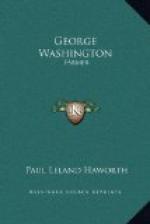No man better understood the value of good clean seed than did he, but he had much trouble in satisfying his desires in this respect. Often the seed he bought was foul with weed seeds, and at other times it would not grow at all. Once he mentions having set the women and “weak hands” to work picking wild onions out of some Eastern Shore oats that he had bought.
He advocated planting the largest and finest potatoes instead of the little ones, as some farmers out of false ideas of economy still make the mistake of doing, and he followed the same principle that “the best will produce the best” in selecting all seed.
He also appreciated the importance of getting just the right stand of grain—not too many plants and not too few—upon his fields and conducted investigations along this line. He laboriously calculated the number of seed in a pound Troy of various seeds and ascertained, for example, that the number of red clover was 71,000, of timothy 298,000, of “New River Grass” 844,800 and of barley 8,925. Knowing these facts, he was able to calculate how much ought to be sowed of a given seed to the acre.
The spectacle of the former Commander of the Armies of a Continent engaging in such minute labor is ridiculous or sublime, according to the viewpoint!
In the spring of the year that he helped to frame the Federal Constitution he “Sowed the squares No. 2 & 4 at this place [Dogue Run] with oats in the following manner—viz—the East half of No. 2 with half a Bushel of Oats from George Town—and the west half with a Bushel of Poland Oats—The east half of No. 4 with half a bushel of the Poland Oats and the west half with a bushel of the George Town Oats. The objects, and design of this experiment, was to ascertn. 3 things—1st. which of these two kinds of Oats were best the George Town (which was a good kind of the common Oats)—2d. whether two or four bushels to the Acre was best—and 3d. the difference between ground dunged at the Rate of 5 load or 200 bushels to the Acre and ground undunged.”
This experiment is typical of a great many others and it resulted, of course, in better yields on the manured ground and showed that two bushels of seed were preferable to four. But if he ever set down the result of the experiment as regards the varieties, the passage has escaped me.




